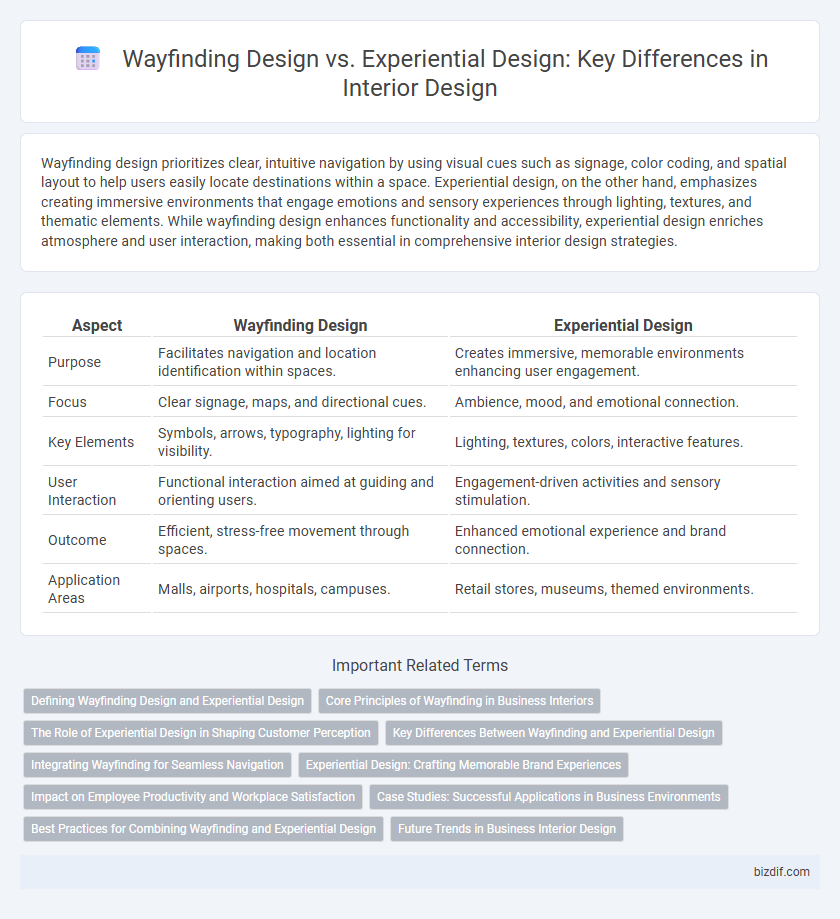Wayfinding design prioritizes clear, intuitive navigation by using visual cues such as signage, color coding, and spatial layout to help users easily locate destinations within a space. Experiential design, on the other hand, emphasizes creating immersive environments that engage emotions and sensory experiences through lighting, textures, and thematic elements. While wayfinding design enhances functionality and accessibility, experiential design enriches atmosphere and user interaction, making both essential in comprehensive interior design strategies.
Table of Comparison
| Aspect | Wayfinding Design | Experiential Design |
|---|---|---|
| Purpose | Facilitates navigation and location identification within spaces. | Creates immersive, memorable environments enhancing user engagement. |
| Focus | Clear signage, maps, and directional cues. | Ambience, mood, and emotional connection. |
| Key Elements | Symbols, arrows, typography, lighting for visibility. | Lighting, textures, colors, interactive features. |
| User Interaction | Functional interaction aimed at guiding and orienting users. | Engagement-driven activities and sensory stimulation. |
| Outcome | Efficient, stress-free movement through spaces. | Enhanced emotional experience and brand connection. |
| Application Areas | Malls, airports, hospitals, campuses. | Retail stores, museums, themed environments. |
Defining Wayfinding Design and Experiential Design
Wayfinding design focuses on creating intuitive navigation systems using signs, symbols, and spatial cues to enhance user orientation within a physical environment. Experiential design emphasizes crafting immersive, multisensory environments that evoke emotional responses and engage users beyond mere functionality. Both disciplines intersect in interior design to balance practical navigation with memorable, emotionally resonant spaces.
Core Principles of Wayfinding in Business Interiors
Wayfinding design in business interiors emphasizes clear visual cues, intuitive spatial layout, and strategic signage placement to enhance navigation efficiency and reduce visitor stress. Core principles include consistency in design elements, use of landmarks and sightlines, and incorporating user-centered paths that accommodate diverse mobility needs. This approach improves overall functionality and supports brand identity by creating a seamless, purposeful journey through the space.
The Role of Experiential Design in Shaping Customer Perception
Experiential design profoundly influences customer perception by creating immersive environments that engage the senses and evoke emotional connections. Unlike wayfinding design, which prioritizes navigation and spatial clarity, experiential design focuses on crafting memorable interactions through lighting, textures, and thematic elements. This approach transforms commercial spaces into dynamic experiences that enhance brand identity and foster lasting customer loyalty.
Key Differences Between Wayfinding and Experiential Design
Wayfinding design prioritizes navigation clarity by using visual cues such as signs, maps, and symbols to guide users through a physical space efficiently. Experiential design enhances emotional engagement by integrating sensory elements like lighting, textures, and interactive features to create memorable user experiences. Key differences lie in wayfinding's functional goal of orientation versus experiential design's focus on atmosphere and user interaction within interior environments.
Integrating Wayfinding for Seamless Navigation
Integrating wayfinding design within interior spaces enhances seamless navigation by utilizing clear visual cues, intuitive signage, and spatial hierarchy to guide occupants effortlessly. Experiential design complements this by creating immersive environments that engage users emotionally while maintaining functional clarity. Together, these approaches optimize user experience by balancing directional efficiency with meaningful spatial interaction.
Experiential Design: Crafting Memorable Brand Experiences
Experiential design in interior spaces prioritizes creating immersive environments that evoke emotional connections and reinforce brand identity through sensory elements like lighting, textures, and interactive features. Unlike wayfinding design, which focuses on navigation and spatial clarity, experiential design aims to craft memorable moments that engage visitors on a deeper, more personal level. This approach enhances customer loyalty and brand recognition by transforming ordinary settings into unique, story-driven experiences.
Impact on Employee Productivity and Workplace Satisfaction
Wayfinding design enhances employee productivity by reducing time spent navigating complex spaces, leading to fewer disruptions and increased focus. Experiential design boosts workplace satisfaction through immersive environments that foster creativity, collaboration, and emotional well-being. Integrating both approaches creates a cohesive office layout that supports efficiency while promoting a positive organizational culture.
Case Studies: Successful Applications in Business Environments
Wayfinding design in business environments enhances navigation through clear signage and spatial cues, as demonstrated in the Mayo Clinic, where intuitive paths reduce patient stress and improve efficiency. Experiential design, seen in Starbucks Reserve Roasteries, immerses visitors with sensory elements and storytelling, creating memorable brand encounters that drive customer loyalty. Both approaches, when integrated thoughtfully, elevate user experience and operational success in commercial interior spaces.
Best Practices for Combining Wayfinding and Experiential Design
Integrating wayfinding design with experiential design enhances user navigation while creating memorable spatial experiences, emphasizing clear signage, intuitive paths, and sensory engagement. Best practices include strategically placing interactive elements that guide users effortlessly and evoke emotional connections through lighting, color, and texture. Utilizing digital technologies such as augmented reality or smart signage optimizes both orientation and engagement within complex interiors.
Future Trends in Business Interior Design
Future trends in business interior design emphasize the integration of wayfinding design with experiential design to create intuitive, immersive environments that enhance employee productivity and customer engagement. Advanced technologies like AI-driven signage, augmented reality, and sensor-based navigation systems are revolutionizing wayfinding by providing personalized, adaptive directions within complex office spaces. Simultaneously, experiential design focuses on multisensory elements, biophilic aesthetics, and flexible layouts to foster creativity, well-being, and brand identity, ultimately driving a seamless balance between functionality and emotional connection.
wayfinding design vs experiential design Infographic

 bizdif.com
bizdif.com